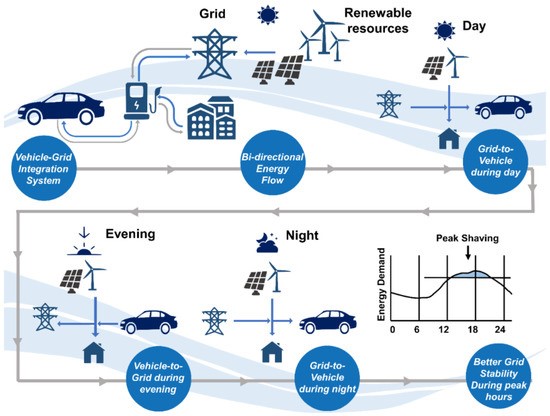Grid-Integrated Fleets: The Nexus of Transport and Energy Decarbonization
EV adoption is picking up. Last year, about 14% of new car sales were EVs, up from 9% in 2021. As more EVs hit the road, a new challenge is arising — how to supply clean energy to meet the charging demand of millions of new EVs.
A crucial piece to this puzzle may be fleets. Sitting at the intersection of vehicle electrification and energy decarbonization, electric fleets pose a significant energy demand challenge to meet their charging needs as well as the untapped potential for energy storage and grid flexibility.
A “Perfect Storm” for Fleet Electrification
Fleet vehicles have an outsized environmental impact. While only making up 5% of global vehicles, fleets account for nearly 30% of vehicle-related emissions due to high use and significant fuel needs of medium- and heavy-duty commercial vehicles. These same factors make fleet vehicles particularly challenging to electrify. They are, first and foremost, mobility assets and charging must be adapted to their operations and logistics routes.
Additionally, heavy-duty commercial vehicles present significant charging demands and costs. Until now, fleet electrification has been stymied by these challenges. However, volatile fuel costs and dropping prices of EVs mean that for the first time, the total cost of ownership of an EV as a fleet vehicle is competitive with, or even lower than, that of a conventional ICE (internal combustion engine) vehicle. Electrification is becoming a smart economic option for fleet operators, while also supporting corporate sustainability and emission reduction targets that focus on last mile delivery and scope 2 emissions.
However, electric fleets face several challenges. Fleet operators do not possess energy and charging management knowledge to efficiently adapt fleet operations and logistics. And in many cases, utilities are unable to meet their charging demands without cost grid upgrades.
Fleet-to-Grid Integration
A solution to these two challenges — the integration of energy and transport management and meeting the energy demand of EV fleets — is through fleet-to-grid (F2G) integration.
Fleet-to-grid integration is the application of vehicle-to-grid integration (V2G) to EV fleets. Through a combination of bidirectional charging hardware and software, vehicles can both charge and discharge back to the grid based on signals received from the grid. At peak hours, EV fleets function as energy storage assets, improving the flexibility and stability of local grids and reducing the reliance on fossil-fuel power plants to supplement grid capacity at moments of high demand.
F2G is particularly attractive due to the large amounts of data readily available related to vehicle location, charging needs, and battery state, facilitating a fast and efficient response to grid signals. For fleet operators, the most attractive element of F2G is the potential to offset electrification and charging costs by tapping into grid service revenue streams, which in turn increases fleet electrification.
Vehicle-to-Grid Integration
Source: MDPO
Innovation Via Software and Grid Services
The unique position of EV fleets, which span both the transport and energy sectors, creates a market opportunity for innovation that optimizes on-site charging and energy management for fleets, as well as for logistics and operations.
- Fleet operations and energy management optimization coordinate vehicle routes with charging/discharging, charging management to reduce facility electricity costs, and power-to-grid applications during peak demand hours (e.g., Evenergi).
- Connecting EV battery management systems to interpret and respond to grid signals is the work with grid operators and utilities to establish grid service plans for EV fleet operators (e.g., Fermata Energy, KrakenFlex).
- DER aggregation are innovative platforms to incorporate EV fleets as distributed energy resources (DERs) and virtual power plants (VPPs) to allow utilities to meet the onsite charging demand of fleets (e.g., Autogrid, Gridcog)
Fleet-to-Grid Challenges
Widespread market uptake of F2G is not a technological challenge — bidirectional chargers and bidirectionally-enabled vehicles are available on the market. In fact, most major automakers have announced the production of bidirectionally-enabled models to release in the coming years. The two main challenges that remain for F2G relate to interoperability and market mechanisms for grid services.
The main challenge is that there is no consensus on which charging standard should be used to allow communication between the vehicle, the charger, and the grid. The result is market fragmentation as automakers and charger manufacturers each interpret the charging standard guidelines in slightly different ways, threatening the compatibility between different vehicles and chargers. For fleet operators with dozens or hundreds of vehicles, interoperability is essential, and lack of clear standards is a serious risk that may deter them from electrifying or engaging in grid services.
Even more, market mechanisms are lacking to tap into the range of grid services that EV fleets could provide, from load shifting to energy storage and flexibility services. Some innovators such as Autogrid are working directly with both fleet operators and utilities to establish turnkey VPP contracts and services that utilities can offer to EV fleets to access some of these services. These contracts allow utilities to meet the high energy demands of EV fleet charging and optimize on-site energy asset management (of onsite EV batteries, renewables, and energy storage) for EV fleets.
Keep a Lookout For…
Despite these challenges, F2G has the potential to spur significant progress towards the decarbonization of both the transport and energy sectors, driving increased EV adoption and providing the energy storage and flexibility services to allow the grid to meet the increasing demand from EV charging.
Crucial milestones for F2G will be the adoption of clear charging standards, the implementation of market mechanisms to allow fleets to engage in grid services, and the production of commercial bidirectionally-enabled vehicles.




